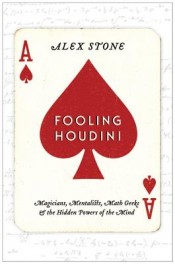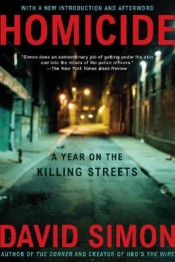Title: Homicide: A Year on the Killing Streets
Author: David Simon
Genre: Narrative nonfiction
Year: 1991
Acquired: Bought
Rating: 




Review: Earlier this year Boyfriend and I spent several months watching straight through all five seasons of The Wire. When we finished, I felt totally adrift and wasn’t sure what to do with myself except spend more time with the police of Baltimore by reading Homicide — a chronicle of the year David Simon spend shadowing detectives of the Baltimore Police Department.
At the time Simon was in the department, every three days two people were murdered in Baltimore. Although each of the detectives in the department has time being the spotlight, there were really three who stood out at the center of the story:
Donald Worden, a veteran investigator; Harry Edgerton, a black detective in a mostly white unit; and Tom Pellegrini, an earnest rookie who takes on the year’s most difficult case, the brutal rape and murder of an eleven-year-old girl.
It’s impossible to read the book and not think of the television show, especially since both focus so heavily on the impact institutions have on individuals. In Homicide, you don’t ever get an in-depth look at the structures outside of the police department, but Simon does show how mandates like a certain percentage of cleared cases and doctoring the numbers to look better (“requests” that come from on high) impact how detectives can do their work.
Homicide is a bleak book and meanders a little bit, but it also shows off Simon’s writing chops. There are these beautiful sections where he steps out of telling the stories of detectives and just plays with the narrative. It’s hard to see out of context, but this section might give you an idea:
This is the job:
You sit behind a government-issue metal desk on the sixth of ten floors in a gleaming, steel-frame death trap with poor ventilation, dysfunctional air conditioning, and enough free-floating asbestos to pad the devil’s own jumpsuit. … You answer the phone on the second or third bleat because Baltimore abandoned its AT&T equipment as a cost-saving measure and the new phone system doesn’t ring so much as it emits metallic, sheep-like sounds. If a police dispatcher is on the other end of the call, you write down an address, the time, and the dispatcher’s unit number ona piece of sctratch paper or the back of a used three-by-five pawn shop submission card.
Then you beg or barter the keys to one of a half-dozen unmarkedChevrolet Cavaliers, grab our gun, notepand, a flashlight and a pair of white rubber gloves and drive to correct address where, in all probability, a uniformed police officer will be standing over a cooling human body.
You look at that body. You look at that body as if it were some abstract work of art, stare at it from ever conceivable point of view in search of deeper meanings and textures. Why, you ask yourself, is this body here? What did the artist leave out? What did he put in? What was that artist thinking of? What the hell is wrong with this picture?
I’m sort of a crime show junkie, so another huge part of this book that I loved was the way it made me look at those shows differently, particularly their reliance on trace evidence (which in real life never helps) and confessions (which rarely actually happen). The reality of police work in Baltimore is pretty bleak, but an addicting read. If you’re missing a fix of The Wire or have an addiction to crime chronicles, Homicide is worth spending time with.
Other Reviews:
If you have reviewed this book, please leave a link to the review in the comments and I will add your review to the main post. All I ask is for you to do the same to mine — thanks!










